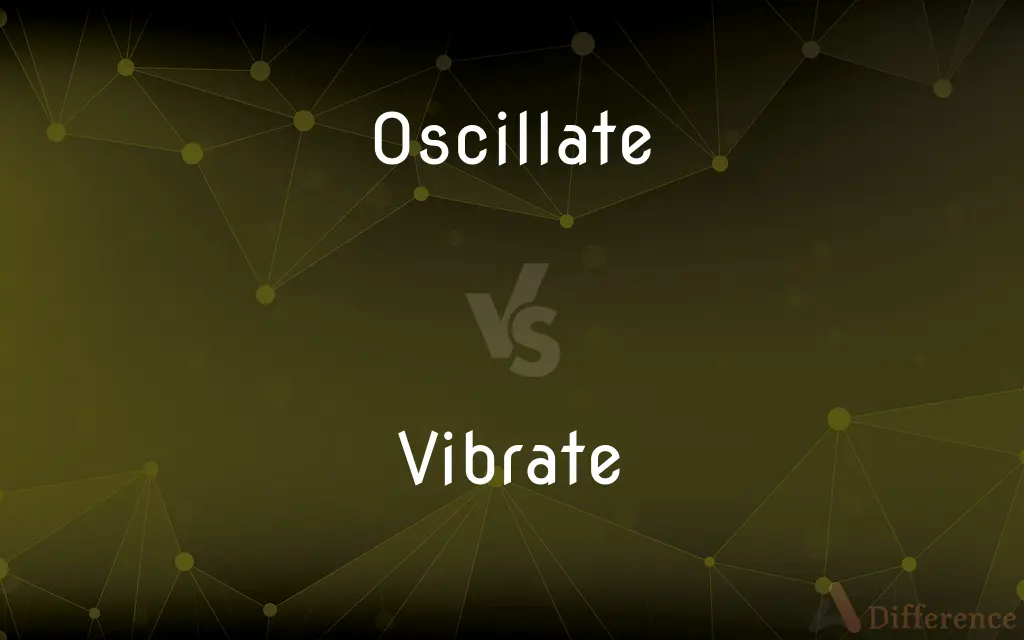Oscillate vs. Vibrate — What's the Difference?
By Fiza Rafique & Urooj Arif — Updated on March 27, 2024
Oscillate refers to the movement back and forth in a regular rhythm, while vibrate involves rapid movement in small distances, often perceived as a quiver or tremor.

Difference Between Oscillate and Vibrate
Table of Contents
ADVERTISEMENT
Key Differences
Oscillation involves a systematic, periodic motion that swings between two points, akin to a pendulum in a clock. This motion is characterized by its regular rhythm and can occur in various contexts, including mechanical systems, electrical circuits, and even social phenomena. On the other hand, vibration is a faster, often less visually perceptible motion, occurring as an object moves rapidly back and forth or up and down. Vibration is usually caused by energy being transferred to an object, causing it to move in quick, short movements.
In mechanical systems, an oscillating motion might be seen in the swinging of a pendulum or the back-and-forth movement of a seesaw. This type of motion is often deliberate and designed into the system for a specific purpose, such as regulating the movement of a clock. Vibration, however, is generally a byproduct of other actions, such as the operation of a motor or the strumming of a guitar string, resulting in rapid, minute movements that can be felt more often than they are seen.
Oscillation can be controlled and modified based on the needs of the system it serves. For example, the length of a pendulum can be adjusted to change the period of oscillation. Vibrations, while they can be modified or dampened, are often inherent to the operation of the device or object and may require specific measures to control or reduce, such as adding dampeners to reduce the vibrations of a machine.
The perception of these movements also differs. Oscillations can often be observed directly because the movements are typically larger and slower. In contrast, vibrations might only be detectable through touch or by the sound they produce, as their rapidity and scale might not be easily visible to the human eye.
Both oscillation and vibration play critical roles in various scientific and practical applications. Oscillations are crucial in timekeeping, signal processing, and even in the study of celestial bodies. Vibrations, on the other hand, have applications in material science, engineering for testing structural integrity, and in creating music through the vibration of instrument strings or membranes.
ADVERTISEMENT
Comparison Chart
Definition
Movement back and forth in a regular rhythm between two points.
Rapid, small-scale movements often resulting in a tremor or quiver.
Perception
Often visible to the naked eye.
Usually felt or heard rather than seen.
Application Examples
Pendulum clocks, seesaws, electrical oscillators.
Vibrating phone notifications, stringed musical instruments.
Purpose
Can be a deliberate, integral part of system design.
Often a byproduct of operation, sometimes undesirable.
Control
Can be adjusted or regulated, e.g., changing pendulum length.
Often requires dampening or isolation to manage.
Compare with Definitions
Oscillate
To move or swing back and forth in a steady, uninterrupted rhythm.
The fan oscillated from side to side, cooling the room evenly.
Vibrate
Often results from the rapid release of energy.
The guitar string vibrated, producing a melodious sound.
Oscillate
Involves movements between two extremes.
The debate continues to oscillate between two opposing viewpoints.
Vibrate
To move rapidly back and forth or up and down with small amplitude.
The washing machine started to vibrate intensely during the spin cycle.
Oscillate
Can be regulated for specific purposes.
The oscillator in the clock controls its ticking motion.
Vibrate
Used in technology for alerts and feedback.
Her phone vibrated to signal an incoming call.
Oscillate
Related to waves and signals in physics and engineering.
The radio waves oscillate at different frequencies.
Vibrate
Can be felt as a tremor or quiver.
The bridge vibrated as heavy trucks passed over it.
Oscillate
Seen in various natural and mechanical systems.
The Earth's climate has oscillated between warm and cold periods over millennia.
Vibrate
Can be a factor in design and engineering to reduce noise and wear.
Engineers use dampeners to reduce vibration in engines.
Oscillate
Move or swing back and forth in a regular rhythm
The grain pan near the front of the combine oscillates back and forth
Vibrate
Move continuously and rapidly to and fro
The bumblebee vibrated its wings for a few seconds
The cabin started to vibrate
Oscillate
Vary in magnitude or position in a regular manner about a central point.
Vibrate
(of a pendulum) swing to and fro.
Oscillate
To swing back and forth with a steady, uninterrupted rhythm.
Vibrate
To move back and forth or to and fro, especially rhythmically and rapidly
The eardrum vibrates in response to sound waves.
Oscillate
To waver, as between conflicting opinions or courses of action; vacillate
"The court has oscillated over the decades from more liberal to less, more conservative to less, depending upon who was president at the time of vacancies" (Gordon J. Humphrey).
Vibrate
To progress in a given direction while moving back and forth rapidly
The sound wave vibrated through the water.
Oscillate
(Physics) To vary between alternate extremes, usually within a definable period of time.
Vibrate
To produce a sound; resonate
“The noise of cars and motorcycles, voices and music vibrates from the street” (Edmundo Paz Solden).
Oscillate
(intransitive) To swing back and forth, especially if with a regular rhythm.
A pendulum oscillates slower as it gets longer.
Vibrate
To fluctuate or waver, as between states or in making choices
“The fear of repetition and the lure of repetition.
Oscillate
(intransitive) To vacillate between conflicting opinions, etc.
The mood for change oscillated from day to day.
Vibrate
To cause to move back and forth rapidly
The rattlesnake vibrated its tail.
Oscillate
(intransitive) To vary above and below a mean value.
Vibrate
To produce (sound) by vibration.
Oscillate
To move backward and forward; to vibrate like a pendulum; to swing; to sway.
Vibrate
A setting on a cellphone that causes the it to shake rapidly without producing a ringtone when a call or text message is received.
Oscillate
To vary or fluctuate between fixed limits; to act or move in a fickle or fluctuating manner; to change repeatedly, back and forth.
The amount of superior families oscillates rather than changes, that is, it fluctuates within fixed limits.
Vibrate
(intransitive) To shake with small, rapid movements to and fro.
Oscillate
Be undecided about something; waver between conflicting positions or courses of action;
He oscillates between accepting the new position and retirement
Vibrate
(intransitive) To resonate.
Her mind was vibrating with excitement.
Oscillate
Move or swing from side to side regularly;
The needle on the meter was oscillating
Vibrate
(transitive) To brandish; to swing to and fro.
To vibrate a sword or a staff
Vibrate
(transitive) To mark or measure by moving to and fro.
A pendulum vibrating seconds
Vibrate
(transitive) To affect with vibratory motion; to set in vibration.
Vibrate
To please or impress someone.
Vibrate
To use vibrato.
Vibrate
The setting, on a portable electronic device, that causes it to vibrate rather than sound any (or most) needed alarms.
Please put your cellphones on vibrate for the duration of the meeting.
Vibrate
To brandish; to move to and fro; to swing; as, to vibrate a sword or a staff.
Vibrate
To mark or measure by moving to and fro; as, a pendulum vibrating seconds.
Vibrate
To affect with vibratory motion; to set in vibration.
Breath vocalized, that is, vibrated or undulated, may . . . impress a swift, tremulous motion.
Star to star vibrates light.
Vibrate
To move to and fro, or from side to side, as a pendulum, an elastic rod, or a stretched string, when disturbed from its position of rest; to swing; to oscillate.
Vibrate
To have the constituent particles move to and fro, with alternate compression and dilation of parts, as the air, or any elastic body; to quiver.
Vibrate
To produce an oscillating or quivering effect of sound; as, a whisper vibrates on the ear.
Vibrate
To pass from one state to another; to waver; to fluctuate; as, a man vibrates between two opinions.
Vibrate
Shake, quiver, or throb; move back and forth rapidly, usually in an uncontrolled manner
Vibrate
Move or swing from side to side regularly;
The needle on the meter was oscillating
Vibrate
Be undecided about something; waver between conflicting positions or courses of action;
He oscillates between accepting the new position and retirement
Vibrate
Sound with resonance;
The sound resonates well in this theater
Vibrate
Feel sudden intense sensation or emotion;
He was thrilled by the speed and the roar of the engine
Common Curiosities
What is oscillation?
Oscillation is a movement back and forth between two points in a regular rhythm.
How do oscillation and vibration differ in their applications?
Oscillation is often deliberately used in systems like clocks and sensors, while vibration is usually managed or minimized in machinery and musical instruments.
Why is vibration considered undesirable in many mechanical systems?
Vibration can lead to wear, noise, and structural fatigue, reducing the lifespan and efficiency of mechanical systems.
What are some natural examples of oscillation and vibration?
Natural examples include the oscillation of planetary orbits and the vibration of molecules in heated objects.
What does it mean to vibrate?
To vibrate means to move rapidly in small distances, creating a quiver or tremor.
Can humans perceive oscillation and vibration differently?
Yes, oscillations are often directly observable, while vibrations may be felt through touch or heard as sound.
Can an object oscillate and vibrate at the same time?
Yes, an object can exhibit both behaviors under certain conditions, like a plucked string oscillating while producing vibrations that create sound.
How can vibration be controlled or reduced?
Vibration can be controlled through dampening materials, isolation techniques, and designing systems to minimize unnecessary movement.
What role does oscillation play in electronics?
In electronics, oscillation is used in circuits to generate signals of a specific frequency, as in radios and oscillators.
How do engineers use knowledge of vibration?
Engineers design structures and machinery to withstand or utilize vibrations, ensuring safety and functionality in their applications.
Share Your Discovery

Previous Comparison
Centrosome vs. Chromosome
Next Comparison
Response vs. RebuttalAuthor Spotlight
Written by
Fiza RafiqueFiza Rafique is a skilled content writer at AskDifference.com, where she meticulously refines and enhances written pieces. Drawing from her vast editorial expertise, Fiza ensures clarity, accuracy, and precision in every article. Passionate about language, she continually seeks to elevate the quality of content for readers worldwide.
Co-written by
Urooj ArifUrooj is a skilled content writer at Ask Difference, known for her exceptional ability to simplify complex topics into engaging and informative content. With a passion for research and a flair for clear, concise writing, she consistently delivers articles that resonate with our diverse audience.
















































